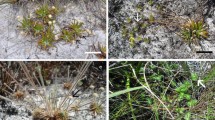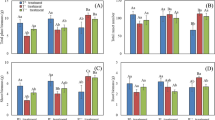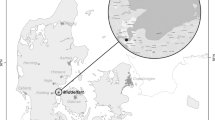Abstract
The dependence of vegetative propagation on the production of individual plants was examined inDisporum smilacinum A. Gray on the basis of shading experiments and field surveys. This species typically showed four types of reproductive behavior: sterile plants producing one plantlet (no propagation), sterile plants producing more than two plantlets (vegetative propagation), fertile plants producing one plantlet (sexual reproduction) and fertile plants producing more than two plantlets (both sexual reproduction and vegetative propagation).
The propagation ofD. smilacinum was clearly related to the annual net production of each individual plant. The probability of a mother plant producing more than two vegetative propagules (plantlets) increased with net production of the plant in the current year. The number of propagules per plant and runner length increased with net production.
It was possible to explain the types of reproductive behavior of this species on the basis of both the initial plant size before sprouting and its net production during the growing season. There was a critical initial plant size for sexual reproduction and a critical level of production for vegetative propagation.
Similar content being viewed by others
References
Barkham, J. P. (1980) Population dynamics of the wild daffodil (Narcissus pseudonarcissus). I. Clonal growth, seed propagation, mortality and the effects of density. J. Ecol.68: 607–633.
Baskin, J. M. &Baskin, C. C. (1979) Studies on the autecology and population biology of the weedy monocarpic perennial,Pastinaca sativa. J. Ecol.67: 601–610.
Bloom, A. J., Chapin, III, F. S. &Mooney, H. A. (1985) Resource limitation in plants—an economic analogy. Ann. Rev. Ecol. Syst.16: 363–392.
Harper, J. L. (1977) Population Biology of Plants. 892 pp. Academic Press, London.
Hayashi, T., Midorikawa, B. &Hogetsu, K. (1967) A study on the efficiency of conversion of reserve substance to active plant body (economic ratio) in the initial stage of growth of potato tuber and rice seed. Jap. J. Ecol.17: 13–20 (in Japanese with English summary).
Hirose, T. &Kachi, N. (1982) Critical plant size for flowering in biennials with special reference to their distribution in a sand dune system. Oecologia55: 281–284.
Horikawa, Y. (1972) Atlas of the Japanese Flora. Vol. I. p. 431. Gakken, Tokyo.
Midorikawa, B. (1959) Growth-analytical study of altherbosa on Mt. Hakkoda, Northeast Japan. Ecol. Rev.15: 83–117.
Kawano, S. (1975) The productive and reproductive biology of flowering plants. II. The concept of life history strategy in plants. J. Coll. Lib. Arts. Toyama Univ.8: 51–86.
Kawano, S. (1985) Life history characteristics of temperate woodland plants in Japan. “The Population Structure of Vegetation” (ed. White, J.), 515–549. Dr. W. Junk Publishers, Dordrecht.
Monsi, M. (1960) Dry-matter reproduction in plants. I. Schemata of dry-matter reproduction. Bot. Mag. Tokyo73: 81–90.
Salisbury, E. J. (1942) The Reproductive Capacity of Plants. 243 pp. Bell, London.
Silvertown, J. W. (1982) Introduction to Plant Population Biology. 209 pp. Longman, London.
van derValk G. G. M., &Timmer, M. J. G. (1974) Plant density in relation to tulip bulb growth. Sci. Horticult.2: 69–81.
Werner, P. A. (1975) Predictions of fate from rosette size in teasel (Dipsacus fullonum L.) Oecologia20: 197–201.
Yokoi, Y., Kimura, M. &Hogetsu, K. (1978) Quantitative relationships between growth and respiration. I. Components of respiratory loss and growth efficiencies of etiolated red bean seedlings. Bot. Mag. Tokyo91: 31–41.
Author information
Authors and Affiliations
About this article
Cite this article
Hori, Y., Yokoi, T. & Yokoi, Y. Production dependence of vegetative propagation inDisporum smilacinum A. Gray. Ecol. Res. 2, 243–253 (1987). https://doi.org/10.1007/BF02349777
Accepted:
Issue Date:
DOI: https://doi.org/10.1007/BF02349777




